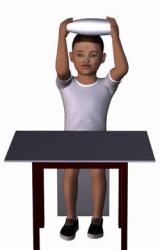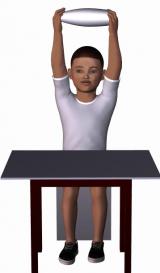Terminology: repetitions, sets and sessions
Repetitions refers to the number of times an action is repeated in succession.
Repetitions are grouped together in sets.
An example: 10 repetitions of stepping up and down from a stool is referred to as one set.
A se tof repetitions is usually repeated 2-3 times with a short rest in between each set.
A session refers to the training period for a specific day. For example a training program may recommend a daily training session, or sometimes 2-3 sessions per week.
The 10 repetitions to fatigue rule
Muscles get stronger when they are made to work against a load that is at least 60-80 % of their maximum capacity. If a group of muscles can do an activity against a load just 10-12 times before they are tired, then you know that the load is good for increasing strength. This is the 10 repetitions to fatigue rule.
You know that the muscles are tiring when the movement becomes slower and is not being performed smoothly. Another indication of tiredness is a tendency to start using momentum to overcome the load.
Example: lifting a bottle of water above the head.
In this exercise Peter is instructed to lift a 2 liter plastic bottle half filled with water up above the head 10 times.




He is able to do this lifting action smoothly for 15 repetitions. The weight is not enough to provide an adequate load. If I fill the bottle with water, he can only do 5 repetitions before he starts to find it difficult to do the movement smoothly. So the load is greater than is needed and may lead to injury.
When the bottle is 3/4 full of water he manages 9 smoothly performed repetitions. So this is the right load for him at this time.
Loading the muscles to increase muscle power
Power is increased when a child does a movement very fast for a 30 second period against a load. An example is standing up and sitting down on a stool as many times as possible in a 30 second time period. The weight of the body provides the load.
Progress is measured by counting the number of repetitions that can be completed in 30 seconds.
Power jumps and throws
Another way to increase power is to do an action that requires an all out effort. Doing a standing broad jump as far as possible is an example of an all out effort that requires good muscle power. Throwing a 2 Kg beanbag as far as possible requires an all out effort of the arm muscles.
The ability to harness the arm and leg muscles' full power depends on good coordination and control.
Power jumps and throws are practiced in sets of 2-3 repetitions with a rest between sets.

